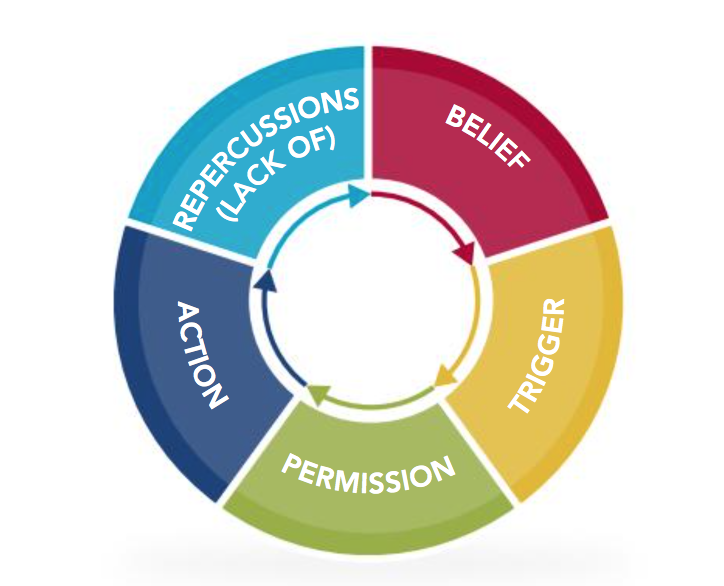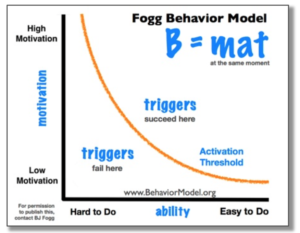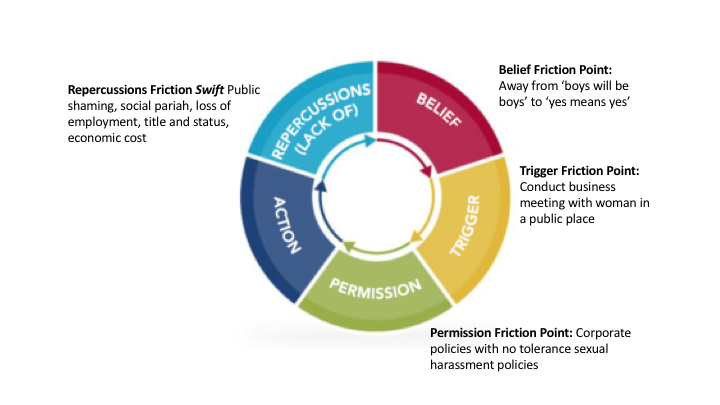
What is the Core Loop of Sexual Harassment?
The number of credible accusers of sexual harassment coming forward of late is creating public conversations around the question of “why does sexual harassment happen so often?”
The Core Loop (as seen in games and digital media) is credible and we believe it applies to sexual harassment as well.
Core Loop of Sexual Harassment (Bennett, Quihuis, 2017)
- Belief: “I’m entitled to express myself sexually to a woman.” “I can do what I want sexually. I don’t need to consider the woman’s feelings.”
- Trigger: “I am alone with a woman I find desirable.”
- Permission: “If I take what I want and she doesn’t fight back it’s ok”
- Action: “Gives the woman unwanted sexual attention”
- Repercussions (Lack of): “Do you think anyone is going to believe a woman?”
As game/behavior designers, we know we can change the outcome of a core loop by changing or adding friction to any of the key steps.
We can also look at BJ Fogg’s Behavior Model, which posits that “three elements must converge at the same moment for a behavior to occur: Motivation, Ability, and Trigger. When a behavior does not occur, at least one of those three elements is missing” (Fogg, 2009).
Looking at the Core Loop of Sexual Harassment, we have the Motivation (which is similar to the Belief), the Ability, and the Trigger (which is the same as our Trigger).
In order to increase the chances of (in this case a bad) action occurring, we can either:
- Increase the Motivation (which is tied directly to Belief and Permission)
- Increase the Ability
- Add more or stronger Triggers in the person’s path
But we are more concerned with decreasing chances of this bad action occurring.
In recent weeks it appears that our culture has reached an inflection point where behaviors that were previously permissible are no longer acceptable.
Conventional thinking is that if a behavior exists and is persistent it can be attributed to human nature and cannot be changed or eliminated. Yet we have examples such as smoking, which was a social norm for centuries, associated with glamour and other positive attributes that is now seen as a downmarket, socially unacceptable behavior.
We may be reaching that point with sexual harassment. As behavior and game designers the long standing core loop for sexual harassment was similar to the core loop for hate crimes.
Core loops and the Fogg behavior model together allow us to look at issues such as sexual harassment and hate crimes in a systematic way. This allows us to see where we can apply friction to different parts of the core loop and learn which interventions are most effective. As is often the case, slowing and eventually stopping harassment of any sort will require a variety of interventions until we reach a threshold where the repercussions outweigh the intrinsic rewards.
What are the new friction points in the Core Loop of Sexual Harassment?
Some people are following the lead of US Vice President Mike Pence by not having meetings or dinners alone with a woman, eliminating the trigger.
In the dialog around sexual harassment there is a changing sentiment around permission.
And most powerfully, real life repercussions are being felt by men who have engaged in sexual harassment.
Bad behavior happens when there are no or ambiguous consequences.
Two key factors have changed the game. One is the aggregate of women’s voices calling out sexual behavior. While there is enormous risk in being a lone voice, there is a type of ‘herd protection’ when hundreds of thousands of women tell their stories through #metoo campaigns in social media.
The other factor is economic. Corporate leaders, studio heads and the like are making economic assessments and cutting sexual harassers loose. In the case of Kevin Spacey and Louis C.K., their television programs have been cancelled, affecting the employment and income of hundreds of people who are associated with those programs, not to speak of the lost potential future revenue of those now shelved media properties. In sectors where networks of people work together, the bad actions of one person can economically impact the network.
As this new core loop gets activated we can foresee a trend emerging where each new charge of sexual harassment reinforces the new core loop and introduces new negative consequences. Over time, social norms change, policies get designed and enforced and entire industry practices will emerge to eliminate sexual harassment. Moreover, as organizations realize that bad actors are replaceable, they will eliminate those individuals to keep the the enterprise economically healthy.
We have seen this in the past with the Sikh-American community on the topic of hate crimes, and we have seen a more positive outcome as Ravi Bhalla became the mayor of Hoboken, NJ despite racist attacks against him.
Back in 2013, Margarita and Chris were working with the Sikh-American community, who were unfairly being targeted by harassers because they “looked” like terrorists to harassers. In the publication Turban Myths, they created the Core Loop of Hate Crimes, which was an earlier attempt to take the Core game loop and apply it to more serious actions.
There are several steps that tend to happen for a hate crime to occur, with some examples of each for purposes of explanation:
Core Loop of Hate Crimes (Bennett, Quihuis, 2013)
- Belief: “Look at that guy in the turban. What is he doing here?”
- Trigger: “That person just set a backpack down next to that building. What if it’s a bomb?”
- Permission: “If I confront this person, I’ll be the hero.”
- Action: “Hey! What are you doing with that backpack? Take that and get out of here!!”
- Repercussions (Lack of): “Do you think they are going to believe the guy with the turban?”
The purpose of a core loop is to diagram what the minimal steps are in a system, and see if those who are in it will continue to move through the loop. So let us look at two examples of the last (Repercussions) step:
“Do you think they are going to believe the guy with the turban?”
“Man, that was awesome. I can’t believe you stood up to that guy. Who knows what was in that backpack.”
versus:
“Do you think they are going to believe the guy with the turban?”
“Why would you do something like that? That guy wasn’t even Muslim. He probably had his laptop or school books in there.”
The Repercussions step is similar to the “Reward” step in a standard core loop for games. But in the case of a hate crime, the reward is both internal (“I felt good and powerful about standing up for that guy with the turban on”) versus external (“The guy at the flower shop gave me a thumbs up. I can tell he didn’t trust that turban guy either.”)
Both the internal and external rewards are important, but by eliminating or negating the external reward, it makes it more difficult for the internal reward to develop. In other words, if a harasser gets negative feedback for their hate crimes, it will be more challenging for them to process it into an internal habit.
But unlike hate crimes which tend to be public, sexual harassment often happens in private, which eliminates an opportunity for a third party to intervene with good (or bad) feedback to the antagonist.
Unlike a core loop for a game, where we want to make the loop stronger to keep people playing, we want to analyze both of these core loops to see where we can break it or slow it down.
When you read stories about bad actors being accused, and analysis around this, remember the Core Loop of Sexual Harassment and what we can do to break it or slow it down in our own lives.
References:
Fogg, B. (2009). A behavior model for persuasive design. Proceedings of the 4th International Conference on Persuasive Technology – Persuasive ’09. doi:10.1145/1541948.1541999
Singh, Jasjit, Quihuis, Margarita, Rodriguez, Giovanni, Bennett, Christopher. (2013). Turban Myths: The Opportunities and Challenges for Reframing Sikh American Identity in Post-9/11 America, SALDEF



